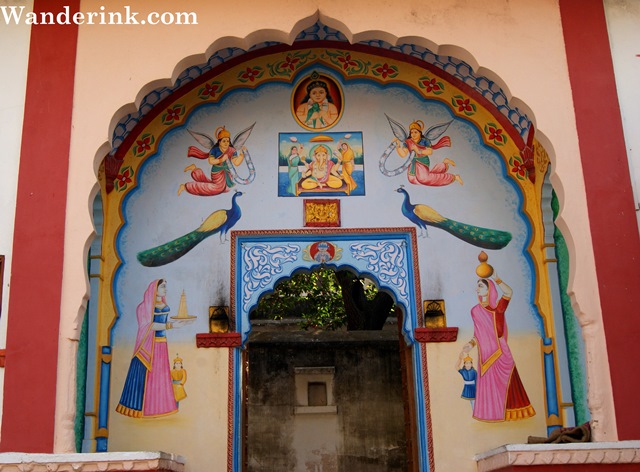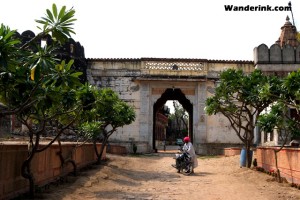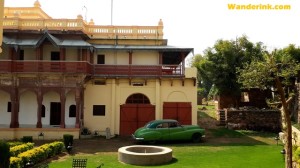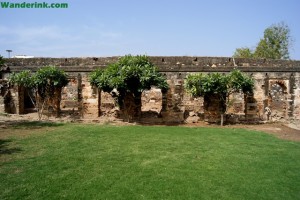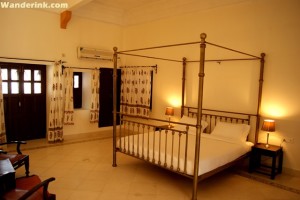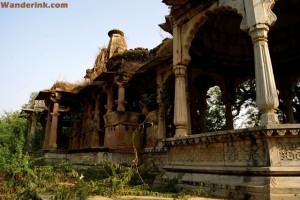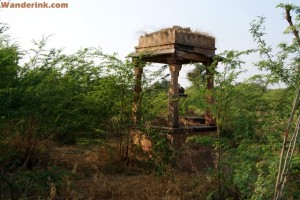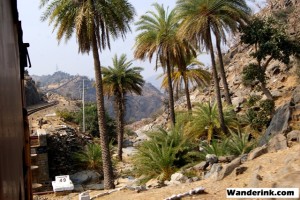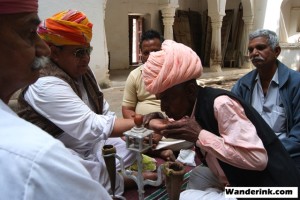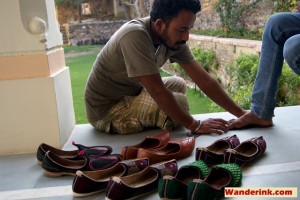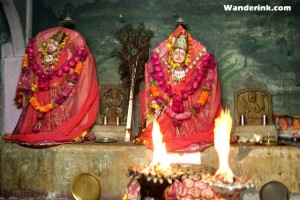The efflorescent shower, marigold garland and crimson tilak – de rigueur of a star-studded hospitality welcome – take valiant moorings when you enter Fort Auwa. Rightly cued, the jeep that picks you up from Marwar Junction stops just short of the yett from where you are requested to proceed on foot allowing the red carpet ceremonies to unfurl in their full sublime import. A Buick is parked at the far end of the bailey – where Thakur Kushal Singh used to assemble his commanders for strategising attacks against the Mughals and the Marathas, the French and the British – today a neatly manicured garden and the al fresco dining area for the guests of the fort in its new avatar as a heritage hotel. The allures where marching sentries kept vigil are today vantage points for glorious sunsets and neat views of a typical desert village.
Most of the original fort was razed to rubble by a vengeful British after Thakur Kushal Singh and his troops swelled the ranks of the protesting sepoys during the 1857 mutiny. Events turned real ugly when Mason, a captain with the British Army, was shot dead and his head displayed publicly in the village square bang by the entrance to the fort. “It was not just the fort they destroyed but the entire village was decimated,” says Surendra Singh, the sixth generation thakur (‘thakur’ essentially means ‘Lord’ and is a feudal title given to ruling members from Rajput dynasties) from Kushal Singh’s line. “Trees were cut down and the village baolis (wells) were filled up with debris.” The eldest of three generations of Auwa thakurs, Surendra Singh says the killing was an ‘act of war’ but condones the brutality of the manner with which it was carried out. “Kushal Singh ji not only deplored the assassination but the Captain was also given a proper Christian burial right in the village itself.” The cenotaph of Captain Mason is just one of the historical gems strewn around Auwa village. Though mauled aggressively by thorny babuls from all sides, the rustic villagers have built a small shrine next to it where most evenings a lamp is lit.
Fort Auwa holds within its redone ramparts the essence of the simple agrarian life that surrounds it. The rebuilding began with the return of Devi Singh, Kushal Singh’s son, to Auwa in 1869 who built ‘Devi Bhawan’, a modest twin-storeyed residence with a plain wooden roof. Successive thakurs over the centuries have added new buildings and wings as per their personal tastes and existing architectural styles. Though not exactly sprawling over a vast acreage, the heritage property encapsulates eclectically Indo-Saracenic architectural styles with Rajput and Mughal elements. Freestone was quarried from Kadu, a village three kilometres away, for most of the construction. Though orillons, oilettes and other typical defence features found in forts are understandably missing here, the thakurs spared no expense when it came to artful embellishments. Hundreds of artisans worked on the elaborate niches carved into scappled ashlars where idols of deities were venerated. Moline cornices with floral designs and intricately carved elephants in full battle-livery adorn the flanking walls leading to the barbican which opens towards to the main garden. A panchaloha gong (five-metal alloy traditionally used to make Hindu deities) next to the wicket which once informed the entire village of the passing hour hangs heavy outside the manager’s office.
While the erstwhile women’s quarters or zenana was converted to the Thakurs’ private residence, the mardana or the men’s building is the heritage hotel today. The property has just 18 rooms and each of them is unique – not just in dimensions and conveniences but also in the way they are done up with local handicrafts and paintings. While the rooms in the ancient building open to a common veranda that faces the garden below, a more recent wing extended from a crumbling bastion has independent private balconies. All the rooms have comfortable double beds and faultless-white linen, study tables, man-sized wardrobes, full length mirrors and spacious en suite bathrooms with shiny vitrified tiled walls. Exclusion of television from the rooms is a thoughtful oversight as well as intercoms – discuss your culinary preferences and set your meal timings in advance. The resident chef is an expert in Rajasthani cuisine; the paneer (cottage cheese) items are certified delish. However, if you feel gastronomically adventurous, try out the papad sabzi and Rajasthani pasta (more chewy and spicy in a non-Arrabbiata way). The dining hall has a low slung arcade cutting through with photographs of the family’s dignitary friends adorning the walls.
The staff of Fort Auwa spoils you with deference; the same bow-head with an earnest ‘hukum’ accorded to the Thakurs starts coming your way too in no time. This becomes a cultural hazard / shock / confusion when Durgapratap, the youngest and the eighth Thakur of Auwa since Kushal Singh, who is officially your host at Fort Auwa, drives you around: the villagers still bow their heads in obeisance. And when you are in a quarter-century-old Willy’s jeep, all it takes to complete the picture would be a ‘safa’ – the natty and colourful headgear, actually a formal – and a functional – requirement in the state, which changes in size and style every 15 kilometres! Buy one from the village shop; the locals who would have gathered around by now will be more than happy to take you through the ‘spins’ before it winds up on your head. If not the safa, then a hat would be handy – the sun is deceitfully hot even in winter – when you head out for the village safari.
Sights and activities
Auwa is typical of any village one sees around a hinterland fort. Progress is labouring through in bullock carts, tethering which seems to be on nobody’s mind. Ownership of television sets is proudly announced through blaring volumes and open doors – everybody’s invited. A motorcycle commands the same social status as a car elsewhere; carries the same number of people too. Men carry mobile phones with the same tenderness as their wives do their babies. The talking points are set timelines missed by passing buses. And now, you. Goes on to show a city slicker how charming rural India can be and an eye-opener for those who thought they had seen the real Rajasthan in Jaipur and Jodhpur.
The Historic Square, with the column erected in memory of those who lost their lives in the 1857 uprising, right by the entrance to Fort Auwa, is also a sort of geographical centre from which the village radiates in all directions. Captain Mason’s cenotaph is just a couple of kilometres from here by the banks of an artificial lake. Of probably less dramatic significance but definitely more historic and architectural merit are the ruins of an ancient temple you pass by along the way. Built over a raised plinth with elaborate relief works and beautifully carved pillars and ornate arches, the villagers are seriously mulling over on how to restore the temple to some of its former glory. Further ahead in the village outskirts is Mahadev Temple with an open ground next to it where the Charans, a tribal community in Rajasthan known for their artistic and literary prowess, hold their annual get-together in April. For a closer look into not just the thakur way of life, but rural Rajasthan itself, visit the family’s farmhouse by the banks of the River Sukri where different crops like wheat, mustard, fenugreek, lentils and barley are grown in cycles. Dipu – Durga’s trusted aide and childhood buddy – whips up some fine kadak chai with biscuits which go well with the sunset from the rooftop. Later in the evening, visit the Thakurs’ favourite goddess, Sukali Mata, at the family temple and witness elaborate puja rituals involving conchs and drums. Chief priest Geeshupuri’s stories (see box) do come from an ethereal realm; then isn’t that what faith is all about.
Auwa is not just about history and heritage and there is more than experiencing rural Rajasthan with a little bit of the ‘thakur way’ thrown in. The region is not shorn of some very interesting sights, intriguing, actually – a green Rajasthan! The best way to see this face of the ‘desert state’ with palms and wadis, rock pools and stone houses is from the train safari. The metre gauge train, only recently converted to diesel engine, passes through the Khamblighat Station 30 kilometres from Auwa before turning around from Phulad junction 22 kilometres away. The stretch which takes hardly half-an-hour by road takes the smoke-spewing grunter over an hour. A delightful journey which traces a parallel along the Aravali range, over the picturesque Kamla Nala and Phulad Dam, through tunnels wafting dark with some of the friendliest people you would have ever met. The rotis they carry are not lunch but to be fed to the monkeys for whom the train, you suspect, stops. (Seasoned passengers say the train is catching its breath.) Most of the locals disembark at the Goramghat Station, one stop before Phulad, from which they climb over a thousand steps to the Goramnath Temple. In case you are feeling peckish after the ride – from all that screaming in the tunnels – try some piping hot mirchi baji and chai topped with mawa (a sweetmeat made from milk) from Phulad station. A slight detour en route to Auwa will take you to Phulad Dam; ambitious plans are afoot to bring more action to the emerald-green waters through boating and angling. Even otherwise it is invigorating to just sit on the soft pebbles of the catchment and enjoy the cool breeze. Make friends with some Rawat elders who saunter by with the same idea.
The village and the train safaris are best savoured over two days. If you have a third day – or part of it – to spare, the chances are brighter for you to get admittance into the inner club of the Thakurs and other village eminences. The frequency of the hathai which is local-speak for sabha or informal gatherings, held at the courtyard of Fort Auwa’s residential wing is not fixed but the agenda invariably is. Issues like land encroachment, husband-wife estrangement and elopement are sorted here.
“The parties are invited to settle their problems only if they do not want to go to the police,” says Pushpendra Singh, Durga’s dad, who officiates over the hathais. “The hathai ensures swift justice unlike police cases which will drag for years.”
The proceedings – in local dialect – may be hard to follow. But of particular interest to outsiders is a very indigenous ritual, the opium ceremony, an indispensible part of these hathais. Arrive a little early and see how opium is purified and diluted using the khalda an instrument shaped like the weighing scale with tapering jute bags hung on both sides and a Shiv linga at the top. Everybody takes turns drinking the watered down opium from the Thakur’s cupped palm and the Thakur drinks from theirs. Hathais are not always solemn problem-sorting affairs but also indispensable part of celebrations like marriage, good harvests and shop inaugurations.
People and products
For those who want to take back more of the tangible, Lakshman and Manoharlal are at your service. Lakshman is the Thakurs’ tailor who will stitch for you the perfect safari shirt with flap pockets and button-up sleeves; Manoharlal the royal mochi will customise a pair of Rajasthani leather jhooti – footwear – as per your design specs and size. In case of large group orders, Fort Auwa will arrange for the ‘tailor-made’ souvenirs to be shipped out to your address. The braver ones can get their hands dirty with Ramlal, the village potter. A frail man with a permanent bemused expression – from his possible inability to fathom tourists’ fascination with the dexterity of his craft – he doesn’t talk much which is left to his wife, Dhaku.
“I do all the colouring on the pots he makes,” Dhaku informs you sprightly. She will take you around their humble showroom and show you the different pots used for various occasions like the jua-jui for example, a post nuptial fun game to decide who will have the upper hand in the relationship. Dhaku assures that the woman usually gets the ring first but leaves in it for the man to find.
In a land of so much valour and sacrifice surely the women too have their share of glory.
The tale of the tilted head
Sukali Mata is the family deity of the Thakurs of Auwa; ‘Su’ stands for everything good – from water to greenery, fame and prosperity. Thakur Kushal Singh used to discuss important matters especially those pertaining to war with Sukali Mata; the goddess’s advice helped the Thakur hold out against stronger, combined forces, for long periods. Kushal Singh’s battlefield manoeuvres and bravado so confounded the British that they sent spies to find the source of his strength and found that it was Sukali Mata. Acting on the advice of some untouchable scelerate , the British decided to desecrate the deity by spilling blood over it. “The Mata ducked to avoid the blood from splattering on her face,” Geeshupuri explains the tilt of the goddess’s head.
The original statue of the goddess went missing for some time and the villagers decided to build another temple and install a newer Sukali Mata – with a straight head. The goddess was installed without incident but those involved in the construction of the temple – including Geeshupuri’s father – came down with grievous physical afflictions which prevented the work from being completed. A Brahmin priest got visions of the original Sukali Mata lying buried under ruins, it was retrieved and placed next to the newer idol. Within a few years, for no apparent reason, the head of the second, newer one became tilted. “Being sisters, they must have decided to be like each other,” Geeshupuri says looking at the statues fondly, lost in a love he claims to exist between two identical divine statues.
Then that’s the romance – not just of little villages tucked in faraway Arcadian corners but of travel itself.
An edited version of the story was published in The New Indian Express.


